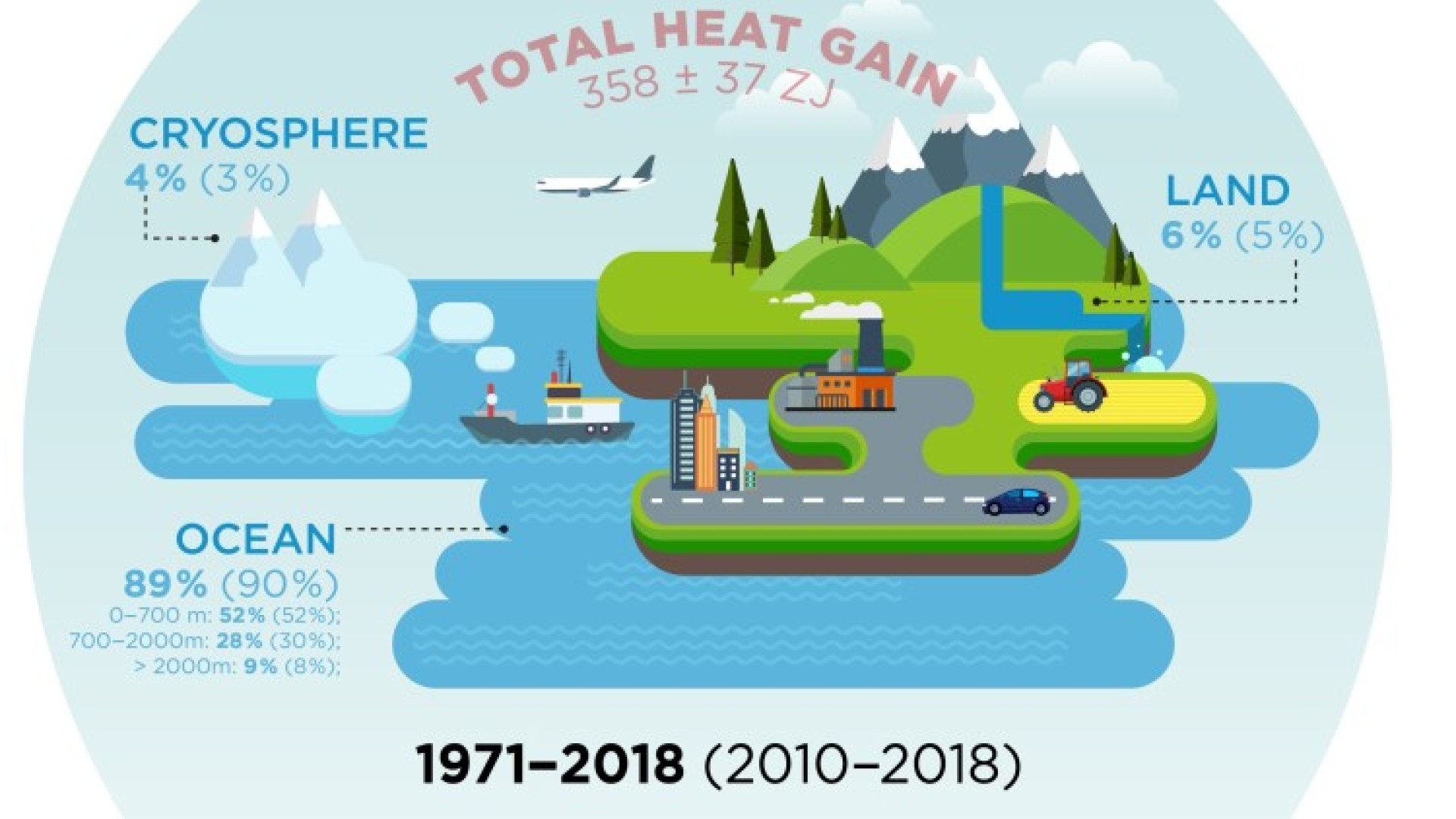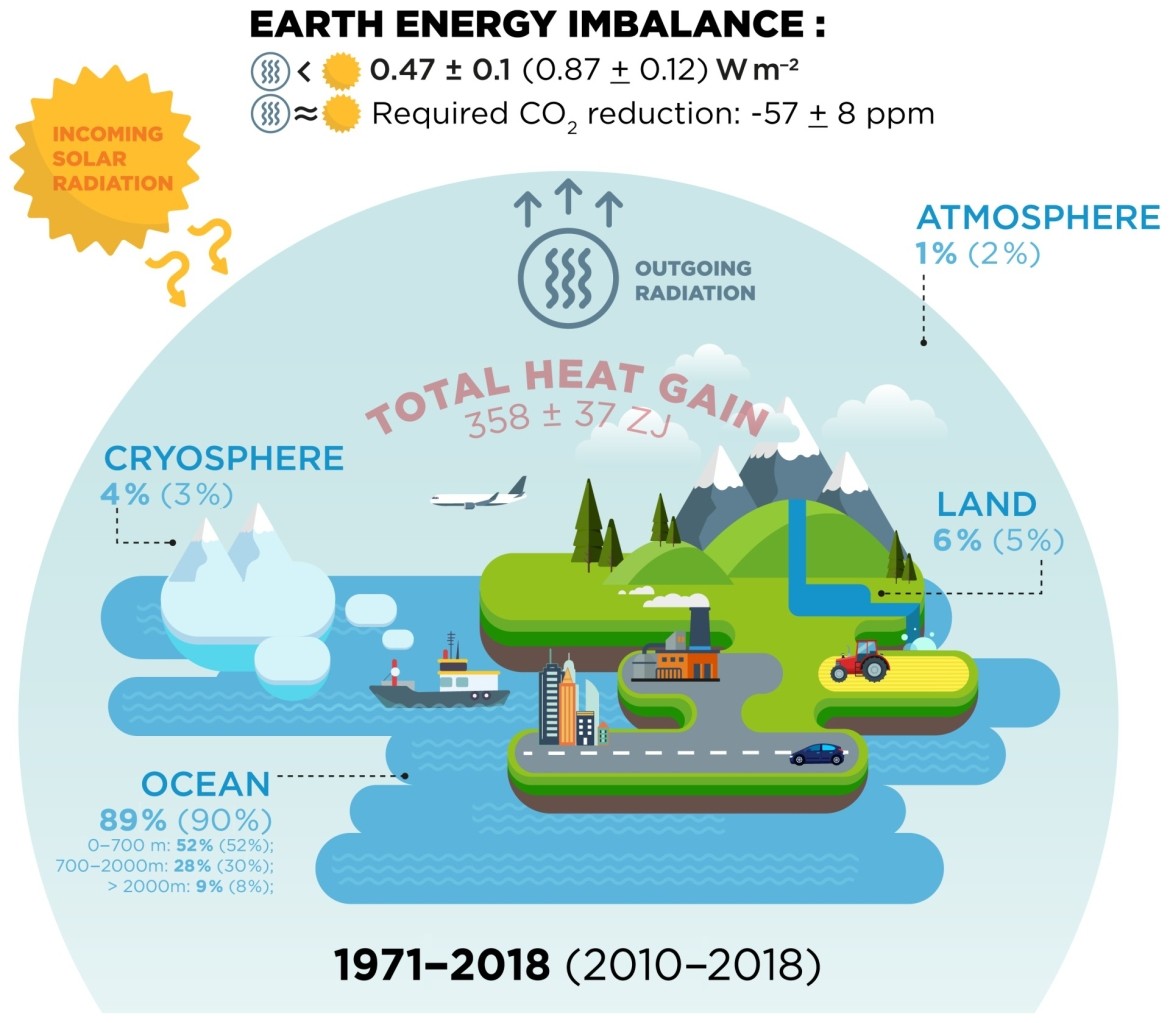
Article written by Kayla Klym (@email)
On September 8th, 2020 the first comprehensive assessment of Earth’s heat inventory was published. The report is based on the concerted efforts of Karina Von Shuckmann and 37 co-authors from scientific institutions across the globe. This collaborative effort supported by the Global Climate Observing System combined cutting edge climate science and a team of multidisciplinary researchers to answer the question of where heat is distributed into the Earth system using a fundamental metric called the Earth Energy Imbalance (EEI). This single number holds significant value in characterizing the current state of Earth’s climate and, along with knowledge of other metrics such as atmospheric CO2 amounts and global surface temperatures, will be critical in our race to understand and mitigate impacts of global climate change.
The EEI is determined as the changes in the global radiation balance at the top of the atmosphere as solar energy arrives at Earth and is radiated back into space. The EEI metric plays a crucial role in determining the temporal evolution of the climate on a global scale. A positive EEI means that less energy is going out than is coming in, and global warming results. As global temperatures continue to rise it is critical to understand where this excess heat is distributed among the land, oceans, atmosphere, and cryosphere and how this will impact society as the Earth system struggles to accommodate heat driven by anthropogenic and natural climate forcings.
The authors conducted a state-of-the-art heat inventory for the time period 1971-2018 that includes an assessment of ocean warming and estimates of heat gains in the atmosphere, on land, and in the cryosphere. Their findings indicate that the EEI is continuing to grow, and that it is also accelerating. Observations indicated a long-term earth system heat gain total of 358 ± 37 ZJ. This is equivalent to a global heating rate of 0.47±0.1 W m^(-2) for the full study period of the past 58 years. The EEI for the period from 2010-20 was 0.87±0.12 W m^(-2), indicating a significant increase in the past decade. The study also broke down the amount of heat gain in the various components of the Earth system for 1971-2018 (2010-2018), with the majority of heat gain reported in the global ocean at 89% (90%), 6% (5%) experienced over land, 4% (3%) available for melting of ice, and 1% (2%) available for atmospheric warming.
The study also detailed what must be done to stabilize the climate and bring Earth back towards an energy balance and quasi-equilibrium. To achieve this the EEI must be reduced to approximately zero, and the amount CO2 in the atmosphere would need to be reduced from 410 to 353 ppm to increase heat radiation to space by .87 W m^(-2).

Unsurprisingly, this reduction of the EEI to approximately zero is no easy task. Awareness of this metric for both the public and scientific community is critical in ensuring that research and observations that support its continued use will be critical to success. Climate stabilization is the central goal of the United Nations Framework Convention on Climate Change (UNFCCC) established in 1992 and the Paris Agreement in 2015, and the authors have called upon implementation of the EEI into the global stocktake as we continue to assess our progress and mitigate the damage already inflicted. We are running out of time in our race to slow global warming, and if we are to make progress in climate stabilization the public and scientific community must be aware of the useful nature of metrics like the EEI and the valuable information included in the heat inventory. For metrics like the EEI to be used effectively as a guide in our progress to mitigate global warming, there must be continued quantification and reduced uncertainties in the heat inventory. If this is to occur the global climate observing system must be maintained and evolved to fill gaps in sampling and establish an international framework for research of the Earth heat inventory.
Dr. James Hansen, prominent former NASA climate scientist and activist for the mitigation of global warming, dubbed the research team “Sentinel of the Home Planet” in a recent article and stressed the importance and attention it deserves if we are to work towards a healthier planet for future generations. He highlighted the importance of reliable monitoring of the energy imbalance, specifically in the oceans as their thermal inertia is the cause of planetary energy imbalance. Previous work by Dr. Hansen, Karina von Shuckmann, and other researchers identified a positive EEI, and the research published in this article serves as a conclusion to the theory that there is a large energy imbalance and that global warming is almost certain based on decadal timescales. This research significantly contributes to understanding aspects of climate stabilization set out in the United Nations Framework Convention on Climate Change (UNFCCC) in 1992 and the Paris Agreement in 2015, and the results will also be included in the IPCC AR6 Synthesis Report: Climate Change set for release in 2022.
A key aspect that made this study so successful was the multidisciplinary and collaborative nature of the research. As we work to produce research to support a sustainable world for future generations, we will need accurate and reliable data that is analyzed in a collaborative manner by experts across the globe in a multitude of disciplines. Two PhD students working at the StFX Climate Services and Research Centre through the StFX-Memorial University of Newfoundland Doctoral agreement - Almudena García-García and Francisco José Cuesta-Valero, and Dr. Hugo Beltrami -StFX’s Canada Research Chair in Climate Dynamics - are contributing authors of the paper. They are responsible for the analysis of geothermal data and the evaluation of the land energy component for this assessment. Their contributions and research align with the goals of the StFX Climate Services and Research Center of tackling questions about climate and climate vulnerability using expertise in climate modelling, climate science, and other social and scientific areas of study. The Center contributes to the training of future scientists to facilitate the development of cutting-edge research included in collaborative studies such as this one.
von Schuckmann, K., Cheng, L., Palmer, M. D., Hansen, J., Tassone, C., Aich, V., Adusumilli, S., Beltrami, H., Boyer, T., Cuesta-Valero, F. J., Desbruyères, D., Domingues, C., García-García, A., Gentine, P., Gilson, J., Gorfer, M., Haimberger, L., Ishii, M., Johnson, G. C., Killick, R., King, B. A., Kirchengast, G., Kolodziejczyk, N., Lyman, J., Marzeion, B., Mayer, M., Monier, M., Monselesan, D. P., Purkey, S., Roemmich, D., Schweiger, A., Seneviratne, S. I., Shepherd, A., Slater, D. A., Steiner, A. K., Straneo, F., Timmermans, M.-L., and Wijffels, S. E.: Heat stored in the Earth system: where does the energy go?, Earth Syst. Sci. Data, 12, 2013–2041, https://doi.org/10.5194/essd-12-2013-2020, 2020.
This research is, in part, made possible by the Government of Canada Research Support Fund.

